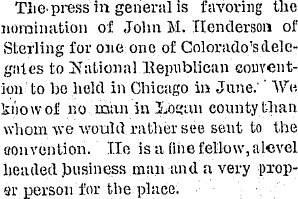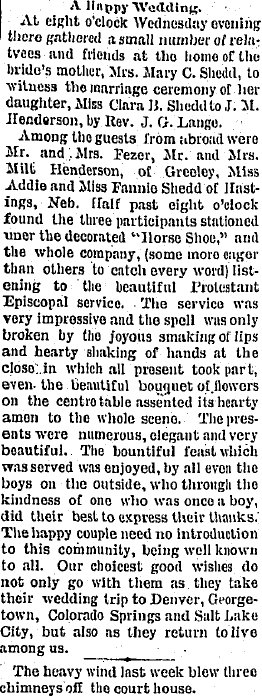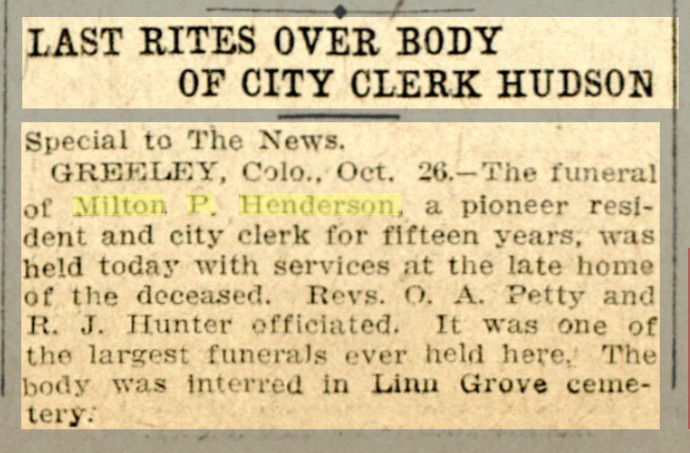It will be recalled that W.L.(Lee) Henderson was the second man to settle in what is now Logan County. He followed closely on the heels of "Uncle Billy" Hatfield, who has the distinction of being the first man to settle and own a piece of land here. No pioneer had more thrilling experiences on the Colorado plains than did Lee Henderson. He is now eighty-four years of age and lives at 630 Ocean Blvd., Huntington Beach, California, and tells some interesting happenings of the early days.
I was born on the 18th day of June 1850, and have just finished a happy contented and satisfied 84th year of my life that had its beginning at Titusville, Penn., nine years before Colonel Drake drilled the first oil well near our home in 1859. Two of my school mates were Ida Tarbel, noted writer, and John D. Archibald former president of the Standard Oil Co.
I graduated from High School, and from Eastman's National Business College at Poughkeepsie, New York. Here I enjoyed many thrills on the Hudson River "ice boats", also visiting the Vassar College girls, keeping in touch as to how they were getting along with their studies.
In the spring of 1872, I came to Greeley, Colo. and joined my brother Milt. Henderson, and M.H. Smith, a cousin, who had come west with the Greeley Colony. They had a bunch of cattle on the range at Freemont's Orchard and had arranged to put up wild hay along the river on land owned by J.B. Kempton. Kempton's wife was the daughter of Elbridge Gerry. It was at this home where I listened to many awe inspiring tales of Colorado's earliest history.
In the years of 1860 to 1870 when there were ever present bands of hostile Indians roving about, imagine the nervious strain on a mother left alone at an early settler's home while the husband was absent on business. Sometimes her imagination at night would cause her to take the children away from the home and hide them until morning for fear the Indians would set fire to the home.
(My grandmother, Pearl Henderson, told me this is what her mother, Rosalind Clark Henderson, did. She hid, with Pearl and John in the rushes along the Platte River.)
In the spring of 1873, the boys arranged with Jared L. Brush of Greeley to handle their cattle with his herd, and with his foreman, S.S. Kampton, we moved the cattle down the Platte River on the south side and located opposite where Illif now stands. We three boys selected homestead filings at Valley Station, opposite Sterling, that my brother was holding under a "squatter's" right before being seconized by the government survey. We built our home, improvements, corrals, etc. of wild grass sod found in low places along the river, and here we lived a ranch life which was filled with many interesting experiences. A few still remain in memory.
I remember we caught a little buffalo calf and raised it with our dairy cows. A band of renegade Indians saw it and killed it with arrows, and informed us it was "their cattle". We did not protest. You know they claimed all the buffalo as their property.
The boys were just as full of pranks in those days as they are now, whether you believe it or not. Right across the river from us lived Mrs. David Leavitt and pretty daughter Minnie. We were all quite friendly with the girls and her ---. One day they decided to take a trip to Greely, to be gone sometime. Minnie put her kitten in a sack and brought it over for us to care for it. While waiding the river the sack and cat fell into the channel. When it reached us it was not very pretty, but we promised to wash the "dough" out of its hair, and care for it until they returned from Greeley. The boys tired of their job. So one morning at the breakfast table one of the gang grabbed a Winchester rifle and the cat and said he was going to shoot it, not meaning to do so, however. We followed him out to see it done. He sat the cat on a little mound, shot, and missed. One of the boys 'guyed'him and said; "I can hit it." He took the gun and hit it, and when the girl and mother returned from Greeley they no longer numbered among their friends.
One of the saddest experiences for us was when Spenser Gunn, husband of the late Nannie Gunn, was thrown from his horse, resulting in his death. Mrs. Gunn was a fine woman, and was a real mother to all of the early cow boys. In 1876, Mrs. Gunn relates some amusing happenings in her writing as to what the settlers did, among them I find the James A. Gragg family, having about seven children, heard noises in the river one night, and thinking the Indians were close, hitched up their horses, gathered up the children, and started to a near neighbor. They had to cross the old railroad grade (which was later abandoned), and in bumping over the grade they lost one of the children and did not know it. He was too busy telling his wife "she should thank God she had so brave a husband to care for her." The lost child was plucky and ran after the wagon crying. The din and noise made by the wagon, the parents mistook the little fellow's cry for Indians and drove the faster. Needless to say, they later drove back for the child.
Our ranch at times would be a meeting place for twenty miles around for the young people to dance. There are four of the girls still living, but they do not dance now. Movie pictures were not necessary at that time for pleasure.
The fall of 1874 thousands of buffaloes on the south side of the river grazed all of the grass from the range, and we were obliged to move our herd to a better range.
During the winter of 1875-76 there was a three day blizzard from the northwest which drove the cattle from the Wyoming ranges to the river by the thousands, including the local range cattle. Many cattle fell from high broken banks walking out on the drifted snow; the same thing occurred where
the snow would drift over the running water at the river. Oh, it was terrible to see the dead cattle when the ice and snow melted in the spring. This same winter there was a steady cold wind for ten days and it drove the cattle from Denver ranges down the river, and as they trailed through the crusted snow
their hair was cut off by the ice. There they stood, refusing to move on account of the pain it would cause. The little calves that could not keep up were left helpless on the trail. In the spring, a number of the weak cattle would go to drink and their feet would get stuck in the deep mud holes and
would be unable to get out. We would rope them and tie the rope on to the horn of the saddle and pull them out, and if they could not then stand up, we ended their suffering either by shooting or cutting the spinal cord where the neck and head join with a long blade knife. It is unpleasant to write the conditions that existed on the open range.
Each spring-generally in June-after the green grass came and the cattle had shed the old hair so that the brands could be seen, the roundup would start with the camp wagons, meeting at a central point to bring stray cattle back to the home range. I was selected to go with the Nebraska roundup, given the right to gather many different brands belonging in Colorado. Before leaving my home camp wagon I unbuckled my cartridge belt with revolver and threw it into the grub wagon and told the cook to keep it until I came for it. The boys who were resting in the shade of the wagon, thought I was foolish and said, "You might need it." A couboy representing some Wyoming brands bunked with me. All went well with us as strangers in a strange land until we rounded up an isolated cow camp where there cows I was gathering.
My turn came to cut cattle from the herd and as I turned them out, the ranchman turned them back. I protested, and he called me every name but a nice one and told me to go and arm myself. I told him I was gathering cattle, and I got the cattle by appealing to the roundup boss. I told my trouble to my "Bunky", and he said, "I would have loaned you my gun." Not long after this, one morning I noticed Bunky and a cowboy ride away from us, arguing about something. I never knew the trouble. At the same moment they shot at each other, sitting on their horses. I saw Bunky fall and I rode up to him; as I raised his head, the man with the smoking revolver shouted, "Let him alone, I want to know if I got him." Bunky answered "Yes." As he rode away he said for me to take the man. When the roundup was over for the day, the boys rolled him up in his blanket and buried him. I took charge of his horse and saddle until a Wyoming sheriff came and took them. He ask me a few questions and said, "That is all of it.."
The large unbranded calves, not with their mothers, were called "mavericks" They were killed for meat on the roundup camps, and others would be branded the same brand for the benifit of the owner of range where found. The old saying: "If you want to eat your own meat, go to your neighbor's", there is nothing to it. The stockmen and owners of cattle respect their neighbor's brands almost entirely. However, I knew of one small owner that wanted more. He tied a branding iron to his saddle and when he saw an unbranded yearling, he would heat the iron in a chip fire, catch the yearling, tie it down and brand it. He branded thirteen in one season. Great droves of Texas cattle were driven north to Montana ranges; they would lose a few head of "dogies". We kept two steers with the bunch for a year and then shipped them with our stock to Chicago. I went with the shipment, and with the proceeds I purchased a gold link watch chain for each of us. I still have mine and the links are so worn that they separate, and it is now a "souvenir."
In those days we had no inspector to bother like they do now. The cattle were shipped to Chicago as there were no Omaha yards at that time. I made several trips in charge of the stock. The cattle were always fed and rested before reaching Chicago, and were always in nice condition when sold. We did
the best we could.
And now for the past ten years, wife and I have lived in California with environments that are restful and pleasant, watching the traffic go by on the ocean boulevard which is the longest in the world, extending from Vancouver on the north to Cape Horn on the south, and as evening comes we sit on the
sunporch and think the man is mad who never dreams of twilight splendor, for no artist yet has conquered such varigated streams that the sun's rays bestow upon the clouds.
Written and signed by an old timer-1872 to 1934 of Sterling, Colo.
Mr. W.L. Henderson now of California. Age 84 years.
__________________________
Thank you.
Diana
John eventually became a barber; the
family lived in Ellis County, Kansas in 1920 and
in Greeley, Colorado in 1930.
Children known from the federal censuses were
(a) Evelyn Henderson, born circa 1912 in Kansas.
(b) John G. Henderson, born (private) in Kansas.



